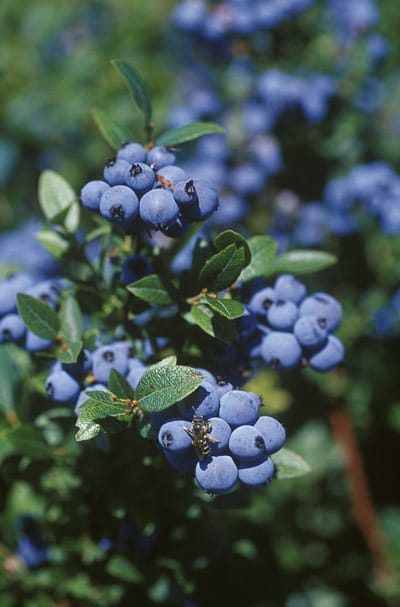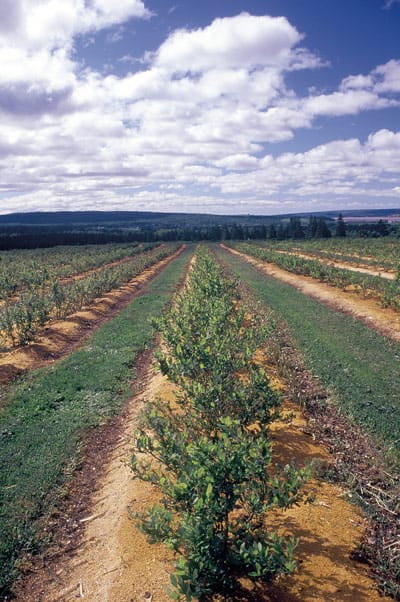Wild or cultivated? Lowbush or highbush? Whichever you prefer, there’s a blueberry for every gardener’s palate and planting scheme.
The Versatile Blueberry
In our modern world of multi-tasking, blueberry plants reign supreme: they effectively do double duty as attractive landscape plants and as prolific producers of nutritious, delicious velvety-blue berries. Plants are attractive all year round, especially in fall when they erupt into a blaze of glorious colour. (If you happen to grow a few cranberries nearby as well, you’ll have a showstopping display.) Birds are happy to share your sweet blue treats with you this time of year—happier, perhaps, than you are to share with them. And as a bonus, plants thrive here on our acidic soils.
The native peoples of Atlantic Canada have traditionally relied on blueberries as a food source, but they were also valued in part because the blossom end of the berry forms the shape of a star, an important nature symbol. First Nations peoples taught European explorers and settlers the food and medicinal value of the little blue berries. At one time blueberries were used to treat people suffering from mental disorders, rheumatism, difficulty in childbirth and other troubles.

Wildly Nutritious Berries
While those who love blueberries have always known they were delicious as well as good for them, research in recent years has revealed plenty of evidence regarding just how “wildly nutritious” blueberries are. Along with being an excellent source of vitamin C and high in fibre, blueberries are low in calories and fat, and have no sodium or cholesterol.
But the most buzz is being generated about their role as nature’s top antioxidant fruit. Antioxidants are naturally occurring substances effective in neutralizing free radicals, compounds connected to a variety of diseases such as cancer and cardio-vascular disease. Research done by the US Department of Agriculture, among others, has shown that blueberries are as much as five times more effective than other sources of antioxidants. Ongoing research has indicated that wild or lowbush blueberries, in particular, may improve night vision, help prevent urinary tract infections and offset ageing effects such as short-term memory loss.
Blueberry Botany
 Whether highbush or lowbush—and sometimes referred to as whortleberries or bilberries—blueberries grow on perennial shrubs that belong to the Ericaceae family, along with such plants as rhododendrons, mayflowers, pieris and heaths and heathers. They are part of the genus Vaccinium, which includes cranberries and bilberries. Highbush blueberries belong to the species Vaccinium corymbosum, while the most common lowbush species is V. angusti-folium, which has a number of variable forms. “Wild” and “lowbush” blueberries are terms used interchangeably for most non-highbush types.
Whether highbush or lowbush—and sometimes referred to as whortleberries or bilberries—blueberries grow on perennial shrubs that belong to the Ericaceae family, along with such plants as rhododendrons, mayflowers, pieris and heaths and heathers. They are part of the genus Vaccinium, which includes cranberries and bilberries. Highbush blueberries belong to the species Vaccinium corymbosum, while the most common lowbush species is V. angusti-folium, which has a number of variable forms. “Wild” and “lowbush” blueberries are terms used interchangeably for most non-highbush types.
In commercial productions, highbush blueberries are planted and tended in much the same way as a fruit orchard is developed, with rows of carefully pruned and tended bushes. Common cultivars include ‘Nelson’, ‘Duke’, ‘Toro’, ‘Jersey’, and ‘Bluecrop’. Lowbush blueberries, on the other hand, are encouraged to develop from stands of native plants. Producers provide the right conditions to encourage plants to spread, which they do by underground runners, or rhizomes. (For more on the cultivation of wild blueberries, see “Wildly Successful”, opposite.)
To make matters even more interesting, highbush and lowbush species have been interbred to create intermediate hybrids, which are shorter than highbush cultivars and bear larger, sweeter fruit. Half-highs range from one to 21⁄2 feet, whereas highbushes may grow to more than six feet in height. If you select these types, which include the cultivars ‘Patriot’, ‘Northland’, ‘Northblue’ and ‘Chippewa’, having two varieties will ensure good pollination and large fruit.
Growing Your Own Blueberries
It may be difficult to locate lowbush blueberry plants at garden centres, but plants in the wild can be divided fairly easily while they are dormant. (There’s little concern about people depleting stocks in the wild because plants are prolific spreaders.) Commercial lowbush blueberry producers are sometimes also willing to share a few plants with home gardeners.
John Lewis, a horticultural consultant with AgraPoint, an agricultural consultancy business based in Kentville and Truro, NS, says that in order to make any blueberry plants feel at home in your garden, you need to emulate their native growing conditions. Fortunately, for most of us in Atlantic Canada, that’s not difficult. Plants need a sunny location in well drained, acidic soil in order to produce well. They can take some shade, but the berry yield will be significantly lower, particularly if the plants are competing with roots of trees and shrubs for nutrients and water.

Acid Soil a Necessity
Blueberries grow best in soils with a pH of between 4.5 and 5. “As a rule, soil here that has never been limed will have a pH of between 4.5 and 5, but it’s best to have a soil test done before you start any sort of amendments,” John says. If you’re growing other ericaceous plants such as rhododendrons and heathers, your soil is probably already suitable for blueberries as well.
Adding peat moss can help to acidify the soil as well as provide organic matter (a benefit if you have compacted or poorly draining soil); you can also use such products as sulphur pellets to acidify the soil. Because many typical garden plants don’t thrive in such an acidic soil, it’s a good idea to develop a dedicated area for your blueberry plants. A mixed planting with other acid loving species, including rhododendrons and azaleas, works well, and can be complemented with such acid-tolerant plants as Shirley and corn poppies, ajugas, hardy magnolias and dahlias.
When planting, John recommends adding a pound of peat (a generous shovelful) to the planting holes of high and half-high plants, both as a source of organic matter that’s slightly acidic and to improve drainage around the plant. If your plants have been growing in pots, be sure to take the time to loosen the root ball and spread the roots out. You may have to do some tearing to release them, making sure they spread out into the planting hole, John says—a common cause of blueberry plants not doing well is that they were root bound when planted.
Although blueberries prefer soil that drains well, they also need a consistent supply of water in order to produce a good crop of fruit. If it’s a dry season, water regularly so the soil is constantly moist but not soggy, as you would for any developing shrubs and perennials.
Remove Blossoms First Year
As difficult as it might sound, in the first year John suggests picking the blossoms off your plants. “Plants will put their energy into developing good root systems so will be well established for years of good production,” he says.
If you choose to fertilize, use formulations designed for acid-loving plants, such as azalea and rhododendron fertilizers. Organic amendments such as blood and bone meal are also useful. A generous (3- to 5-inch) layer of pine needles, pine bark, or other bark-type mulches helps to keep the soil moist as well as reduce weeds and gently feed the soil. However, highbush blueberry roots tend to grow into the mulch zone, so be prepared to top up your mulch every year or so. In normal home gardening conditions, blueberries are not much troubled by pests.
Although it may be hard to be patient (especially after having picked off those blossoms the first year), resist the urge to pick your blueberries as soon as they turn blue. They haven’t yet had a chance to develop their full sweetness. Leaving them for up to a week—provided, of course, that birds and other wildlife don’t get them all first—will ensure a sweet crop.
Wildly Successful
North America is home to all of the world’s wild or lowbush commercial blueberry crop, with approximately 50 per cent produced in Canada. There are commercial operations in all four Atlantic provinces as well as in Quebec.
Most commercial wild blueberry production takes place on land where the species is normally found growing wild. Unlike other crops, lowbush blueberries are not planted but are developed from existing colonies of native plants—by providing ideal conditions of acidic, humus-rich soil, good drainage and adequate moisture, conducive to plants thriving and multiplying—while other species of plants are hindered from growing. Plants spread by underground runners or rhizomes, and in a good year, a single rhizome can spread more than a foot.
All the new growth from one rhizome has similar characteristics, so you’ll often hear bushes referred to as clones. A field will consist of many rhizomes and many different clones, hence the variation in berries, fall colour, etc. It can take as long as 10 years for a new field to produce a good crop, during which time the grower receives little or no income.
While lowbush blueberries produce a crop every year, most producers harvest a particular field only every other year. They tend to have a number of fields and have at least half their acreage in production each year. Some producers burn their fields in the fallow year, while others are now opting to mow them. Pruning by either method stimulates vigorous growth and high yields. Those who prefer burning argue that it also reduces the incidence of disease, weeds and insects.
Today’s lowbush blueberry crop is harvested primarily by tractor-mounted harvesters, which can cover up to three acres over a 10 hour day. However, fields that are developed on uneven, rocky ground require the use of hand pickers with blueberry rakes.
Following harvest, the fruit is put through a specialized blower to remove leaves, twigs and other detritus, and then sold as fresh fruit or sent for processing. Much of the lowbush crop goes to processing plants for IQF (Individually Quick Frozen) treatment. The fruit freezes extremely well, and is usually available in five to 10-pound boxes in grocery story freezer sections throughout the year.
Growers are always looking at ways to generate additional income from their crop by developing new products, ranging from chocolates with dried blueberries to blueberry wines. One of the most intriguing products is wild blueberry juice, produced and marketed by long-time wild blueberry producer Case van Dyk of Caledonia, NS. Currently his juice production plant is at Agriculture Canada’s research station in Kentville, but he plans to develop another site as the juice end of this family-run business grows. Van Dyk’s 100 per cent pure Wild Blueberry Juice is available at retail outlets throughout Atlantic Canada and beyond.
